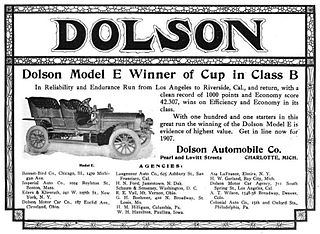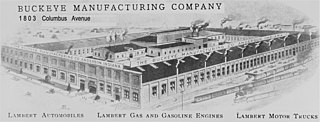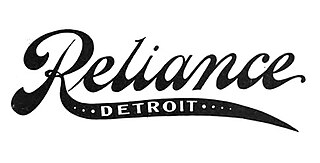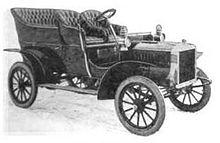
An antique car is an automobile that is an antique. Narrower definitions vary based on how old a car must be to qualify. The Antique Automobile Club of America defines an antique car as over 25 years of age. However, the legal definitions for the purpose of antique vehicle registration vary widely. The antique car era includes the Veteran era, the Brass era, and the Vintage era, which range from the beginning of the automobile up to the 1930s. Later cars are often described as classic cars. In original or originally restored condition antiques are very valuable and are usually either protected and stored or exhibited in car shows but are very rarely driven.

The Peerless Motor Car Company was an American automobile manufacturer that produced the Peerless brand of motorcars in Cleveland, Ohio, from 1900 to 1931. One of the "Three Ps" – Packard, Peerless, and Pierce-Arrow – the company was known for building high-quality luxury automobiles. Peerless popularized a number of vehicle innovations that later became standard equipment, including drum brakes and the first enclosed-body production cars.

Fisher Body was an automobile coachbuilder founded by the Fisher brothers in 1908 in Detroit, Michigan.

Baker Motor Vehicle Company was an American manufacturer of Brass Era electric automobiles in Cleveland, Ohio, from 1899 to 1914. It was founded by Walter C. Baker.

Phelps Motor Vehicle Company was a manufacturer of automobiles in Stoneham, Massachusetts, between 1903 and 1905. In 1906 it was succeeded by the Shamut Motor Company.

Single Center Spring Buggy Company was an American carriage and automobile manufacturer based in Evansville, Indiana. The Single Center factory manufactured the Zentmobile, Zent, Windsor, Worth, Single Center, Evansville, Simplicity and Traveler automobiles from 1903 to 1910.

The Union automobile was a vehicle manufactured by the Union Automobile Company from 1902 until 1905. It was designed by John William Lambert, who had developed the three-wheel Buckeye gasoline buggy in 1891. Over the next decade, Lambert substantially refined the vehicle, with modifications including an additional wheel, a more powerful engine, and a new transmission system. The Union Automobile Company was formed as a subsidiary of Lambert's Buckeye Manufacturing Company solely to manufacture the Union, which took its name from Union City, Indiana, the city where it was built and which endorsed its production. In total, the company built over three hundred Union automobiles, before development shifted to the Lambert automobile, the Union's successor.

The Lambert Automobile Company was a United States automobile manufacturing company which produced the Lambert automobile from 1905 to 1916. The company was founded by automotive pioneer John William Lambert and was based in Anderson, Indiana.

The Dolson was a brass era automobile manufactured in Charlotte, Michigan by the J.L. Dolson & Sons from 1904 to 1907. They later changed the company name to the Dolson Automobile Company. The Dolson was a large car with a 60-horsepower engine. They offered a touring car boasting seven seats that sold for $3,250 in 1907. It was advertised as the "Mile-a-Minute" car. They also offered smaller vehicles, with chain and shaft-driven 20 hp flat-twins, and a shaft driven four of 28/30-horsepower.

The Riker was a veteran and brass era electric car founded in 1898 in Elizabeth, New Jersey. Designed by Andrew L. Riker, they were built in small numbers until the company was absorbed by the Electric Vehicle Company in 1901.

The Paterson was a Brass Era/Vintage car built in Flint, Michigan from 1909 until 1923.

The Buckeye Manufacturing Company was a company noted for manufacturing gasoline engines and farm implements. It manufactured the engines for its sister company, the Union Automobile Company.

The Buckeye gasoline buggy, also known as the Lambert gasoline buggy, was an 1891 gasoline automobile, the first made in the United States. It was also the first automobile made available for sale in the United States. It was initially a three-wheel horseless carriage, propelled by an internal combustion gasoline engine; it was later developed into a four-wheel automobile with a gearless transmission, and mass-produced during the first part of the twentieth century. The platform was later expanded into a line of trucks and fire engines.

The Union Automobile Company was an automobile factory to manufacture the Union automobile through the Buckeye Manufacturing Company. It began manufacturing automobiles in 1902 and produced them through 1905. The company was located in Union City, Indiana.

The Regal was an American automobile produced by the Regal Motor Car Company of Detroit, Michigan, from 1907 to 1918.

The Rauch & Lang Carriage Company was an American electric automobile manufactured in Cleveland, Ohio, from 1905 to 1920 and Chicopee Falls, Massachusetts, from 1920 to 1932.

The Brass era Reliance automobile was manufactured by the Reliance Automobile Manufacturing Company in Detroit, Michigan from 1904 to 1907.

Edgar Apperson was an American automobile manufacturer and engineer.
Leo Melanowski was an American automotive engineer in the Brass Era.




















